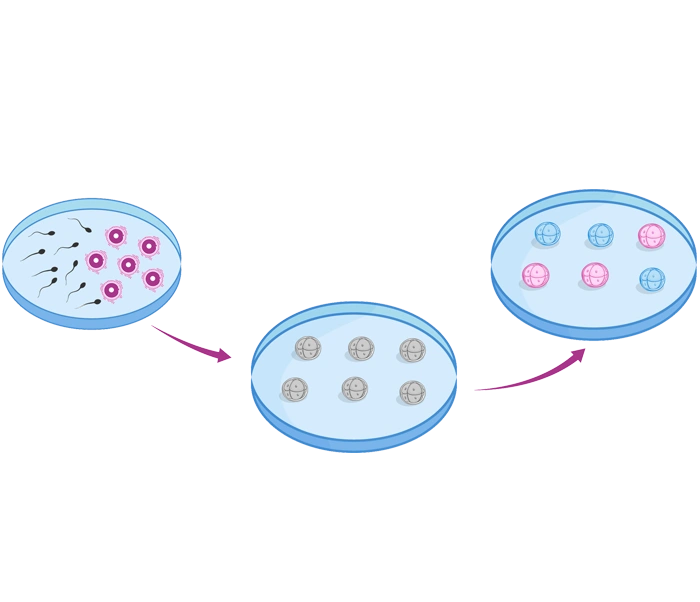Gender Selection: Advanced and Accurate Scientific Infertility Treatment
Gender selection prior to pregnancy is a reliable and scientific way to ensure the desired child’s gender. It is a modern and popular method in infertility treatment that enables couples to determine the gender of their child before embryo transfer into the womb, using advanced technologies. In this article, we will explore this method in detail, its advantages, how it works, and the individuals who are suitable candidates for this treatment.
What is Gender Selection and How is it Done?
In the gender selection process, specialists use techniques such as PGD (Preimplantation Genetic Diagnosis) or PGS (Preimplantation Genetic Screening) to determine and select the gender of the embryo before it is transferred to the mother’s uterus. This is typically done during IVF (In Vitro Fertilization) treatment.
Main Technologies Used in Gender Selection:
- PGD (Preimplantation Genetic Diagnosis):
- Precise examination of the embryo’s chromosomes
- Selection of male or female embryos
- Over 99% accuracy rate
- PGS (Preimplantation Genetic Screening):
- Overall chromosomal health screening
- Prevention of genetic abnormalities
- Selection of a healthy and desired gender embryo
- MicroSort (Less Common):
- Separation of X and Y chromosome-carrying sperm
- Lower success rate
- Limited availability in many countries
Why is Gender Selection Done?
- To prevent sex-linked genetic diseases such as hemophilia, muscular dystrophy, etc.
- To create gender balance in the family
- To fulfill personal, cultural, or religious preferences of the parents
- To increase the chances of selecting a healthy embryo during IVF
Benefits of Gender Selection Treatment
| Benefits | Description |
|---|---|
| High Accuracy | Over 99% accuracy in gender selection with PGD and PGS |
| Prevention of Genetic Diseases | Screening and elimination of genetically unhealthy embryos |
| Increased IVF Success Rate | Selection of healthy embryos with high implantation potential |
| Family Planning Flexibility | Selecting the desired gender and timing for parenthood |
Who is a Suitable Candidate for Gender Selection?
- Couples who already have children of the same gender and wish to have a child of the opposite gender
- Families with a history of specific genetic disorders
- Couples who require IVF due to advanced age or fertility issues
- Individuals who have specific personal, cultural, or religious preferences for the gender of their child
Limitations and Ethical Considerations
- Need for IVF: Gender selection can only be done in conjunction with IVF.
- Higher Costs: Gender selection involves additional genetic procedures, making it more expensive than regular IVF.
- Legal and Ethical Considerations: In some countries, gender selection for non-medical reasons is restricted.
Conclusion
Gender Selection treatment, using advanced technologies such as PGD and PGS, is one of the most accurate and effective methods in infertility treatment. This method not only helps increase the chances of IVF success but also ensures the genetic health and desired gender of the child.
If you or your partner are considering IVF and are interested in gender selection, this method can be a scientific, safe, and reliable option for you.
The Role of Nutrition in Gender Selection
In the journey of infertility treatment aimed at gender selection, nutrition plays a crucial complementary and effective role. While determining the exact gender can only be achieved through scientific methods such as IVF and PGD, diet can significantly enhance the chances of success by preparing the woman’s internal environment.
Balancing Body pH Through Nutrition
Some scientific studies suggest that a woman’s diet can alter her body pH levels, especially the environment within the uterus. These changes can influence the survival and motility of certain sperm types (X or Y). Y sperm, which result in a male child, thrive and are more active in an alkaline environment. In contrast, X sperm, which result in a female child, are more stable in an acidic environment. Therefore, women who wish to conceive a boy are advised to follow an alkaline-forming diet, while women hoping for a girl should adopt an acidic-forming diet.
Diet for Increasing the Likelihood of a Male Child
To enhance an alkaline environment and support the success of Y sperm, a diet rich in minerals such as potassium and sodium is recommended. Fruits like bananas, dates, and avocados, foods like potatoes, and moderate consumption of natural salt fall into this category. Additionally, consuming protein sources like red meat and eggs, while reducing dairy intake, can also be effective.
Diet for Increasing the Likelihood of a Female Child
To support an acidic uterine environment, foods rich in calcium and magnesium are recommended. Dairy products like milk, yogurt, and cheese, as well as leafy vegetables like spinach, nuts like almonds, and citrus fruits, can help create an environment favorable to X sperm. Reducing salt intake, red meat, and high-potassium foods is also advised.
Ideal Time to Start a Gender Selection Diet
For optimal effectiveness, it is recommended to begin a gender selection-specific diet at least two to three months before undergoing fertility treatments or IVF. This time frame helps adjust the body’s pH levels to the desired state.
Healthy Nutrition for Overall Treatment Success
Regardless of the gender selection goal, maintaining a healthy diet can enhance both egg and sperm quality. Drinking plenty of water, consuming fresh fruits and vegetables, avoiding processed foods, and taking supplements such as folic acid, vitamin D, and omega-3 are general recommendations for improving fertility health and increasing success in gender selection treatments.
Conclusion
Although nutrition alone does not determine the gender of the embryo, it plays an essential role in preparing the body to receive a specific type of sperm, thus enhancing the success of gender selection treatments. Combining a targeted diet with advanced fertility technologies helps couples increase their chances of achieving their desired child. To achieve the best results, this diet should always be designed under the supervision of a doctor and a fertility nutrition expert.

















